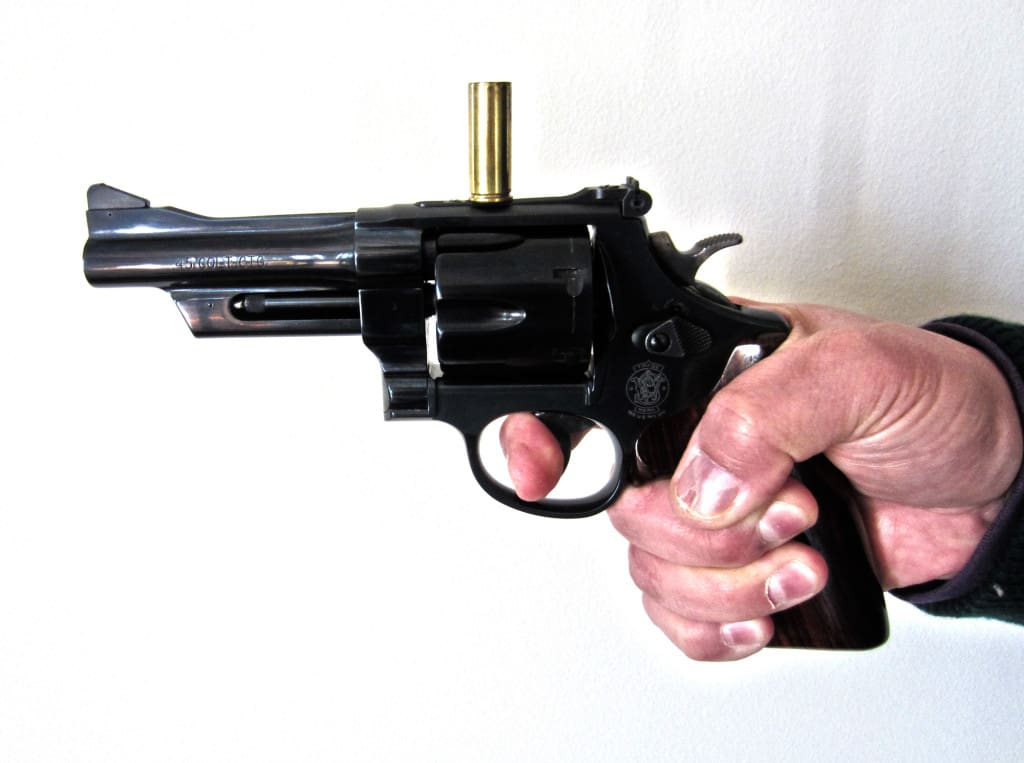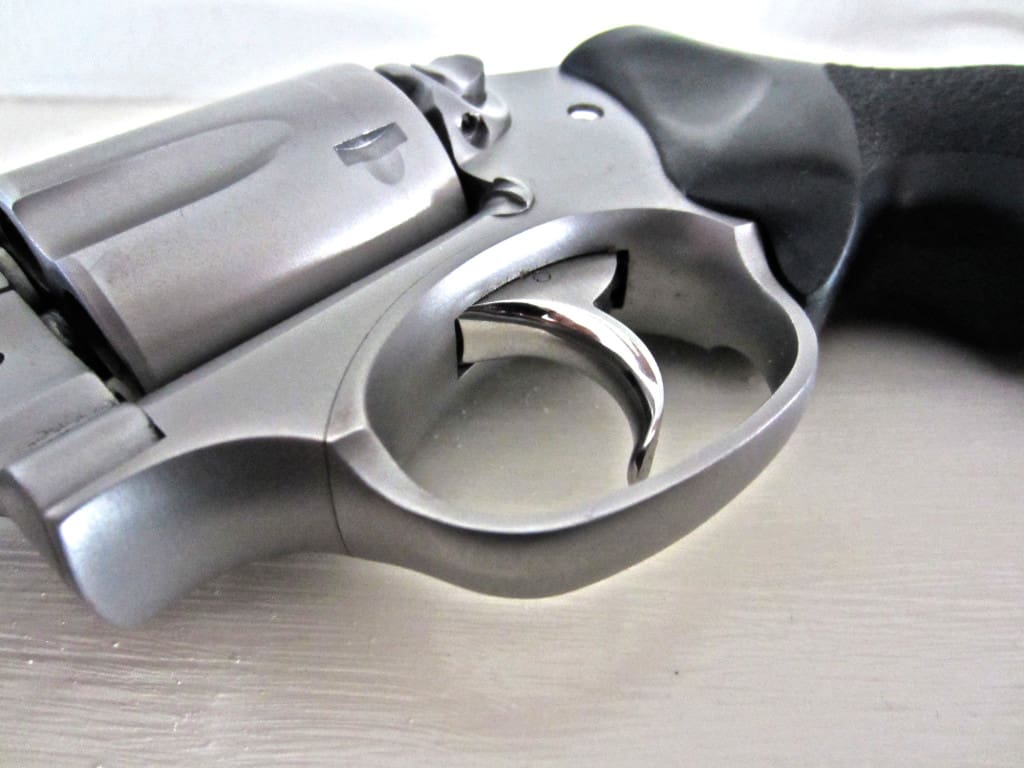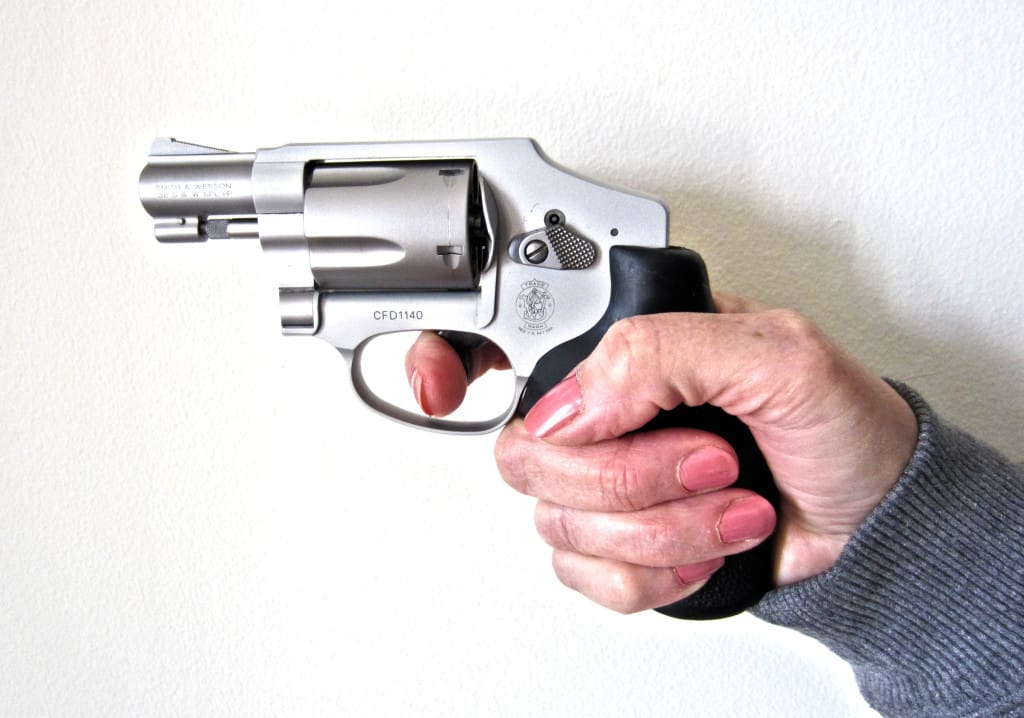By Constantine via concealednation.org
Trigger control is one of the fundamental elements of shooting. Combined with grip, stance, sight alignment and breathing, you must master trigger control to shoot accurately, quickly, and with confidence. If you carry a double-action revolver, DA/SA semi-auto, or DAO semi-auto, you will have a trigger which is long and heavy compared to the single-action pull on a 1911 or Hi-Power. With the traditional double action pistol, the first pull is the long DA variety, followed by the shorter, lighter SA pull when the hammer is cocked. The key to good DA trigger control is minimal disturbance of the sight alignment from beginning to end. Even when “point shooting” at very close range . . .
it is important to keep the gun aligned toward the target. This takes some practice, but it is not difficult if you go about training the right way.
What is good DA trigger control? To attempt to describe it; it is not a “jerk,” “squeeze,” “press,” or a “yank.” It is more of a “roll” or a “stroke.” Let’s break that down. Good DA trigger action is controlled from start to finish. It is neither too fast nor too slow. To achieve this, the trigger finger must move independently of all other muscles of the firing hand. If you are increasing the pressure of your grip while actuating the trigger, you are moving the gun around. The pressure of the thumb and all other fingers should remain constant. The wrist should be firmly locked and stationary.
Further, the ideal DA trigger action should be at constant speed from beginning to end. You start pulling and pull on through until the shot breaks. Some trainers recommend “stacking” or pulling until you feel an increase in resistance, then breaking the shot. I disagree with this approach. Many excellent DA triggers present constant resistance throughout their entire travel, so you cannot “stack” them with any certainty.
At worst, this technique could lead to prematurely firing a shot. Although this is no big deal on the range, it could be disastrous in a live-fire situation. As a point of information, I refer to a Glock trigger as a “two-stage” trigger. This has a light take-up stage, followed by increased resistance. A shorter, heavier pull is then required to fire the shot. This is different from a double-action trigger, which offers fairly uniform resistance.

Here is how to develop and maintain that double-action trigger control. This is a dry-fire technique which you can practice at home. First, make sure that your firearm is completely unloaded. Put the ammunition aside. Then, grip the firearm in the usual manner. Take a firm, but not overly tight grip. If your knuckles are white, you are gripping too hard. Hold the gun level at about waist height. Place an empty cartridge case on the top strap of a revolver or on the top of the slide of a semi-auto. Now, pull the trigger through in one motion without causing the cartridge case to fall off the gun.
After you can reliably do this, try two shots in succession, then three, etc. Practicing in this manner will help you remove any trace of jerkiness from your trigger pull. Doing this exercise for 15 minutes twice a day will shrink the size of your groups on the range and eventually increase your speed at double action firing. Remember, go for smoothness first. Speed will come.

You will find this technique much easier to master if your firearm fits you properly. For a good double-action pull, your finger should engage the trigger at the first joint, not on the tip. The trigger itself should be smooth, narrow, and have a fair amount of curvature to it. If the trigger reach is not right, sometimes installing an after-market grip will correct the situation. Some manufacturers offer a number of different triggers so you can change the reach by swapping out parts. If the trigger reach is too long, you may find that a different firearm is more suited to the size of your hand.
Whatever your chosen firearm, practice frequently to improve and maintain your skill. Not all practice needs to take place at the range. Practice pays off in increased confidence. Stay safe.





Instead of a spent casing, I use a quarter. Excellent dry fire drill.
I know it’s lazy but I just pull the hammer back, now it’s single action. Plus the other party now knows you mean business.
Cocking the hammer by hand is certainly an option for some, but not for all. I’m 70 years old, and my thumb doesn’t work so pretty good anymore – and it would be seriously a problem in an emergency. 🙂 I have a 5 pound trigger on the .357 revolver, and I have no trouble shooting that accurately double action.
The XD 9mm I carry all the time doesn’t have a hammer to cock…
That doesn’t work so well on DAO…
I know, my first handgun purchase 35 years ago was a Ruger Police Service Six and I grew up shooting DA/SA.
It’s like shifting a manual transmission. After a while you just don’t even think about it any more.
They know I mean business as soon as it’s unholstered.
That makes sense – we learned trigger pull by dry firing with a quarter balanced on the front sight post on the C-7.
I watched a video on YouTube about doing a trigger job on a GP100 Ruger so I tried and it was really pretty easy.
The results were nothing short of remarkable.
It now has one sweet trigger and all I needed was two dollars worth of fine wet/dry sandpaper.
Please provide a link to that video or a title (and length of video) so we can find it!
What is the link to that video?
I just bought an LCR, it’s pretty freakin smooth
The LCR has an awesome trigger for a DA revolver.
Is my favorite EDC gun (S&W 642) a ladies gun? Dreadful!
I thought that is what the Glock 42 and Ruger LC380 were for.
I do dry fire practice quite a bit with the 642 and the Rossi 461.
With the DA/SA guns that I have (SR-22 and CZ82), I’m sometimes surprised by how light the SA is compared to the DA.
I think some start out that way, until the first time they fire it. I’m sure there are some ladies that do well with it, but it takes dedication.
Good article. Looking forward to adding this drill to my practice.
Sorry but the very top photo is truly silly to demonstrate the proper hold on a hammerless revolver. In that manner the revolver will jump right out of your hand. The web of the shooting hand needs to ride as high as possible on the grip frame to be able to manage it.
+1 My thoughts were that you ain’t gonna hit anything holding a gun like that!
stance is not critical. what stance are we using when we shoot on the move? which is what you should be doing during a combat situation.
Good heavens! Please do not EVER thumb-cock your DA revolver!
Not if there’s even a whisper of a chance it might be used for self-defense. Not ever, ever, ever.
I see it all the time on the training and IDPA ranges: that thumb waving around while the shooter’s brain sorts through the options.
Plus, any notion that you’ll have any useful fine-motor-control during a life-or-death situation, the kind you need to thumb-cock, is absurd. Your thumb will never get there, accurately or in time.
Finally, your attorney will kill you if he or she finds out you cocked your gun in a threatening manner in order to “send a message”.
Just don’t thumb-cock your gun. Please don’t.
Also- please take down that first picture- my hand hurts thinking of that poor woman firing that gun, which she clearly is in need of professional help with.
Why do people think that during life and death situations all motor fine motor control goes out the window. This has been proven wrong again and again.
Because they have never been in a life-or-death situation.
The original purpose of the DA/SA trigger on revolvers was that DA was for up close, can’t miss range when taking the quarter second it takes to thumb cock the hammer isn’t an option. SA was intended for well aimed shots. DA was never originally intended to be used when accuracy was a high priority. With enough practice you can achieve great accuracy with DA, but IMHO the original philosophy is still the best one. If someone is shooting at me in a crowd or from more than 15 yards or so, I’m thumb cocking the hammer. If the legal authorities make a stink about it my excuse is that I could have hit an innocent bystander in DA (see NYPD 12 lb. Glock triggers).
I would agree that cocking the trigger for Hollywood effect is a bad idea, generally, but if you cock on the draw it doesn’t really take any longer to fire SA anyway. If you have to pull the trigger slowly and methodically to make an accurate shot, SA would be faster.
BTW, why do you think they put those hammer spurs on DA revolvers?
For bullseye shooters and hunters.
So it’s OK to miss your target and hit an innocent bystander in a self defense situation, just don’t cock the hammer with your thumb like you’re some sort of cowboy or something?
BTW, the same DAs that will give you shit about cocking the hammer will also try to crucify you for using hollow points or +p ammo.
Vast majority of DGUs in my area don’t even get to a grand jury or hearing.
So what did all those guys in the “wild west”, where single action wheelguns were the norm, do in a crisis? Use their hoglegs as clubs?
How about reloading a trapdoor springfield in the middle of a battle? I’d say that qualifies as fine motor skills.
No wonder the Old West was safer than modern times, everyone’s thumbs turned to flippers when they pulled out their SAA Colts! Each participant in a gunfight could only get off one (if they were lucky) shot before their brain imploded.
My finger is literally aching just with the thought of double action triggers. I cut my right index finger to the bone as a child and while surgery made it so it is mostly normal, it did lose significant strength and range of motion.
Single action and striker fired triggers are fine, but I can manage maybe one or two shots from a double action before my finger just can’t pull the trigger anymore.
Do you have an index finger on your other hand?
Learning to shoot left-handed is not as hard as it sounds. It just takes practice. Think of all the switch-hitters in baseball.
I’m left-handed but I learned to shoot and do certain other things right-handed, just because I knew it would make life easier (scissors, computer mouse, etc.).
It might be worth a try.
My favorite DA triggers are on my early 70’s Smith’s, Model 27, 17 and 14.
The DAO trigger on my Kahr is very loong, and does not break until the trigger is almost to the rear of the guard. I’ve found that it operates far better with a single smooth pull all the way through, as the OP suggests, works far better than trying to stack the trigger and then pull through to firing. The former way is easy, the latter pretty difficult.
Agreed. Kahr triggers are as close to double action revolver triggers as you’ll find on a semi. Looooong and smooth.
I don’t have any “true” double-action firearms, but I do have a Kahr, S&W, and Ruger that are “double-action style.” This article has a LOT of great advice–much of which I had to learn the hard way when learning to shoot the long, heavy trigger on my first pistol.
However, I do disagree with one point: “For a good double-action pull, your finger should engage the trigger at the first joint, not on the tip.” In my experience, using the first joint, rather than the tip, results in the muzzle dipping as the trigger breaks. No matter how much I practice, I can’t seem to keep the sights on target with that method.
From what I have read, the reason behind using the first joint (a.k.a. the distal joint) is to increase leverage in order to help overcome the heavier trigger weight. However, I’m not lacking in hand strength (I’m in construction), nor are the trigger pulls on my firearms particularly heavy (8 lbs is the max), so I don’t see the benefit of using that particular technique.
tl;dr- if you’re physically capable, try the tip first (that’s what she said)
The advice offered is almost identical to what I tell candidates who I am certifying to be NRA instructors. As for the J-frame revolver photo, a high hold position is preferable, but not all hands are built alike. I find that small-handed individuals often are forced to use a lower hold in order to successfully reach and manipulate a strong DA trigger. It is only a shooter’s perception that recoil is greater with a low hold. In fact, the recoil energy is the same, but the whip (barrel rise and rotation) may lead to a longer recovery time between shots. That could place a shooter at a tactical disadvantage, but it’s better than the alternative.
Great write up.
I love me some DA shooting and my Model 27 continues to mystify and challenge me, I think mostly because my hands are simply too small for it. I did recently change to magna grips though, and that made a big difference in trigger control and achieving a high grip at the same time. I’d recommend trying a slimmer grip option for someone with small hands to get better trigger control.
Comments are closed.